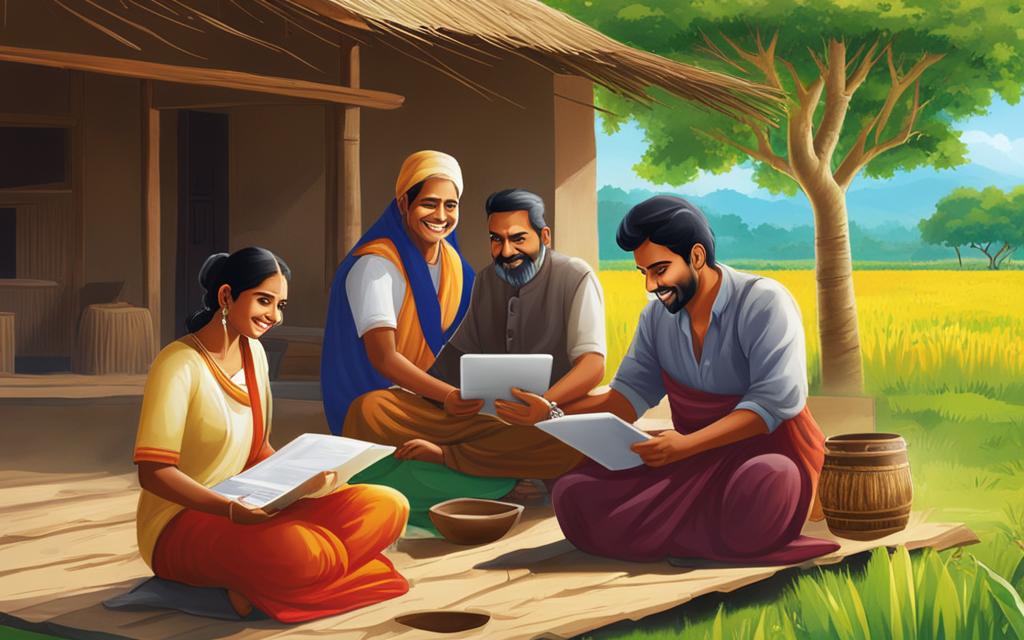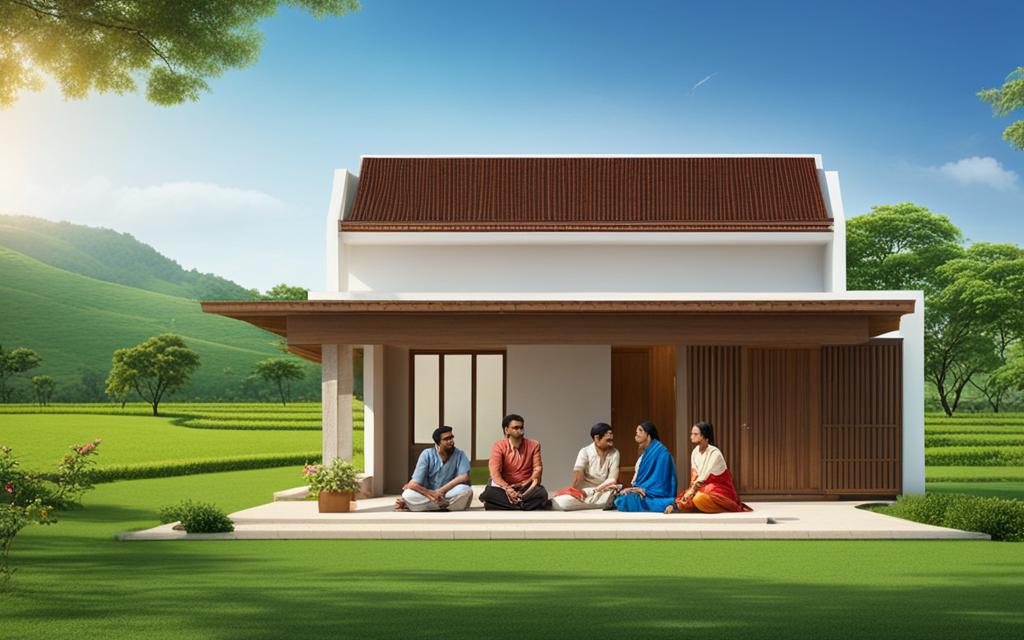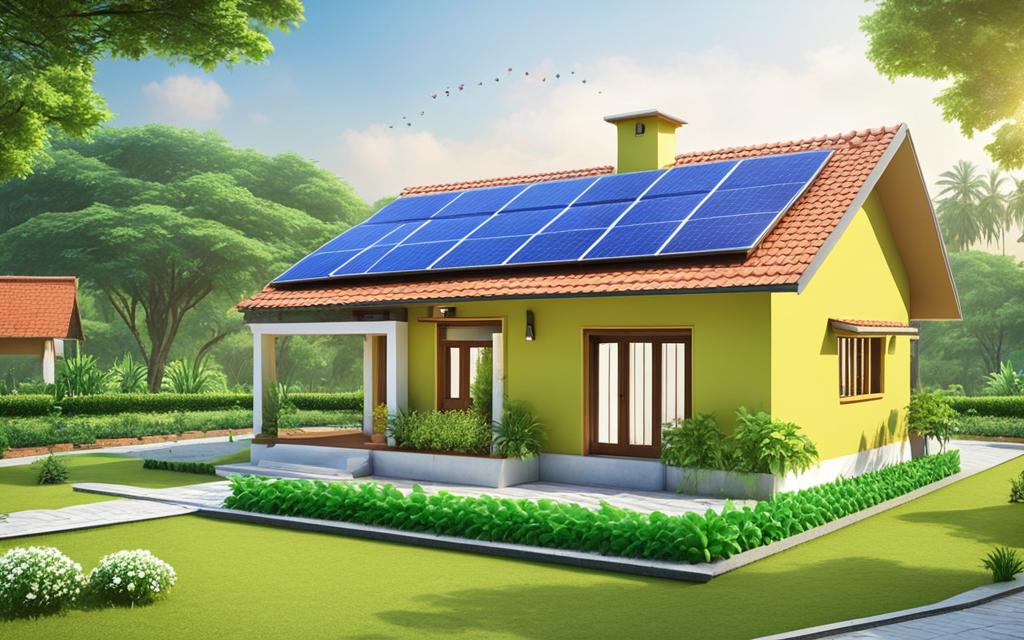The quest to deliver a sustainable home to every family in rural India is a foundational pledge deeply ingrained in the nation’s development goals. The Pradhan Mantri Awas Yojana Gramin (PMAY-G) stands at the forefront of this ambitious undertaking, significantly transforming lives through its comprehensive approach to eradicate homelessness. Conceived with the determination to provide shelter to the less privileged, PMAY-G ensures a world where the rural populace can dream of a safe and sturdy roof over their heads, echoing the sentiment of progress and hope.
Key Takeaways
- Pradhan Mantri Awas Yojana Gramin catalyzes societal transformation by securing housing for the rural poor.
- Financial aid offered through PMAY-G initiates a ripple of economic upliftment and stability.
- The scheme emphasizes the construction of eco-friendly, sustainable homes.
- PMAY-G bridges the gap between ambition and reality for many, leading to noteworthy improvements in living standards.
- Focused implementation ensures that the benefits reach the eligible populace, bringing transparency to the forefront.
Understanding the Pradhan Mantri Awas Yojana Gramin (PMAY-G)
The sweeping journey from the Indira Awas Yojana to the current Pradhan Mantri Awas Yojana Gramin signifies a pivotal shift in India’s approach to rural housing. The PMAY-G history encapsulates over three decades of governmental efforts, crystallizing into a program that addresses the pressing needs of rural communities for adequate, durable shelter.
The Genesis of PMAY-G and Its Evolution from IAY
The predecessor of the PMAY-G scheme, the Indira Awas Yojana (IAY), was initially established to contribute to the welfare of the rural poor by providing them with housing. Since its inception, IAY marked the beginning of a substantial government intervention in the rural housing sector. The IAY to PMAY-G transformation in 2015 enhanced the scope, scale, and efficacy of the rural housing initiative, not merely by changing the nomenclature but by overhauling its approach to embrace inclusivity and sustainability.
Core Objectives of the Pradhan Mantri Awas Yojana Gramin
The essence of the Pradhan Mantri Awas Yojana Gramin scheme lies in its objectives geared towards elevating the living standards of rural populations. Central to its mission is the provision of financial assistance, enabling beneficiaries to build sturdy homes, thus offering a foundation for a stable future. Beneath the broader umbrella of affordable housing, the scheme prioritizes individuals below the poverty line, underscoring a commitment to reach the most vulnerable. Additionally, the Pradhan Mantri Awas Yojana Gramin eligibility criteria are instrumental in ensuring that the aid reaches the right individuals.
| PMAY-G Objectives | Details |
|---|---|
| Financial Assistance | Providing subsidies for constructing residential units |
| Inclusivity | Targeting the economically weaker sections and marginalized groups in rural areas |
| Sustainability | Encouraging the use of eco-friendly construction materials and practices |
| Improvement of Living Standards | Ensuring a decent quality of life through secure housing |
Eligibility Criteria for PMAY-G Beneficiaries
Securing a place under the Pradhan Mantri Awas Yojana Gramin (PMAY-G) requires understanding its eligibility requirements thoroughly. This pivotal social welfare program is crafted to lift the rural populace out of homelessness and inadequate living conditions by offering tangible housing solutions to those most in need. To navigate the steps towards successful pradhan mantri awas yojana gramin application, one must first identify with the outlined demographics and then proceed with the stipulated registration formalities.
Identifying the Demographics for PMAY-G
The demographics targeted by PMAY-G encompass the most vulnerable sections of Indian rural society. These primarily include individuals with neither a sturdy home nor sufficient means to build one. Scheduled Castes (SC), Scheduled Tribes (ST), and non-SC/ST categories in rural areas are given priority. The intent is to embrace every eligible person under the purview of PMAY-G beneficiaries, ensuring that the benefits of the scheme reach where they are most required.
Understanding the Application Process for Eligible Participants
The formalities for pradhan mantri awas yojana gramin registration are streamlined to inclusivity and accessibility. Commencing with verifying one’s eligibility on the official PMAY-G list, the application route mandates the submission of demographic and financial information. This stage is crucial to confirm that all potential beneficiaries align with the program’s criteria, as it aims to provide housing security tailored for individuals who find themselves on the lower end of the economic spectrum.
Eligibility verification plays a significant role in the distribution of benefits, and transparency in this process is pivotal for the optimal functioning of the scheme. The list of pradhan mantri awas yojana gramin beneficiaries is meticulously compiled, taking into account the candidate’s income level, existing living conditions, and vulnerability to housing instability. The final objective is to uphold the scheme’s integrity by serving the rightful claimants.

Applying for Pradhan Mantri Awas Yojana Gramin
Fulfilling the aspirations for a secure and robust dwelling in the rural hearts of India, the pradhan mantri awas yojana gramin online application procedure is an initiator of change for the eligible. As the scheme’s guidelines illuminate the path for applicants, it’s paramount to adhere strictly to the pradhan mantri awas yojana gramin guidelines to facilitate a seamless application experience. Here’s the consolidated compass to navigate through the official digital avenues.
Commence by gathering the necessary documents which are pivotal in affirming your eligibility. This compendium must include:
- Aadhaar Card Number
- Consent documents for utilizing Aadhaar
- MGNREGA worker details, if applicable
- Swacch Bharat Mission number
- Bank account details for direct benefits transfer
With the documentary essentials in hand, the pursuit for a home transitions to the virtual sphere where you must fill in the precise details in the application form. Navigate through the form meticulously, ensuring that all data keyed in is accurate, thus averting future setbacks.
| Document | Description | Purpose in Application |
|---|---|---|
| Aadhaar Card | 12-digit UIDAI issued number | Primary identification and authenticity of applicant |
| MGNREGA Details | Job card number if registered | Priority determination for beneficiaries |
| Swacch Bharat Number | Associated number with the mission | Linkage for sanitation facility provisions |
| Bank Account Details | Account number and associated IFSC | To facilitate direct benefits transfer |
After form submission, remain patient as your application embarks on the journey towards approval and fruition. During this interim, the importance of adhering to the guidelines becomes pronounced to ensure your application stands in favorable light.
Once your application is embellished with the status of ‘accepted’, it represents the conquer of a significant milestone in availing a home under the Pradhan Mantri Awas Yojana Gramin scheme. This first stride embarks you on a new journey, one towards a self-owned home that stands firm on the horizon of rural India’s evolving landscape.
A Close Look at Pradhan Mantri Awas Yojana Gramin Benefits
The Pradhan Mantri Awas Yojana Gramin (PMAY-G) has been transformative for rural housing in India, ensuring that those in need can envision a secure and stable future in their own homes. With the central focus on uplifting the quality of life for rural households, PMAY-G extends a pivotal array of financial benefactions and additional supports.
Financial Assistance and Subsidy Information
One of the cornerstone features of the PMAY-G is the provision of substantial financial assistance and subsidies crafted to address the varied geographical needs of applicants. Predicated on the topographical categorization, the scheme disburses different subsidy amounts to ensure the equitable creation of durable homes—known as ‘pucca’ houses—across the plains and highland territories. Here, recipients from nondescript terrains are eligible to receive up to ₹120,000, whereas those dwelling in areas fraught with geographical challenges are endowed with assistance up to ₹130,000.

Additional Advantages for PMAY-G Beneficiaries
Beyond the financial aid, the Pradhan Mantri Awas Yojana Gramin benefits envelop a broader spectrum of advantages, ensuring that the beneficiaries’ journey towards homeownership is as seamless as possible. The scheme champions transparency at each juncture, selecting recipients through a process designed to foil the interference of intermediaries. The strategic utilization of Direct Benefit Transfers (DBT) further cements the efficacious channeling of funds. PMAY-G astutely addresses not only the housing structure but also the integration of necessary amenities within these abodes to buttress a wholesome living environment, thus fostering inclusivity and elevating the overall well-being of rural communities.
Key Features of the Pradhan Mantri Awas Yojana Gramin Scheme
The Pradhan Mantri Awas Yojana Gramin scheme (PMAY-G) is a significant governmental initiative that stands as a beacon of hope for the rural population in India. It aims to provide an accessible path to homeownership for the economically disadvantaged, focusing on environmentally sustainable construction and comprehensive welfare. To convey the essence of this transformative project, let’s delve into the specific aspects that underscore its commitment to social upliftment.
By fostering inclusivity and technology-driven systems, the PMAY-G ensures no citizen is left behind in India’s march towards comprehensive rural development.
- An Inclusive Selection Process: Ensuring that the rural poor are not sidelined, the PMAY-G mandates a meticulous beneficiary selection to promote fairness and reach.
- Eco-Friendly Housing: A testament to India’s dedication to sustainability, the scheme advocates for housing designs that reduce environmental footprints.
- Government Scheme Convergence: By aligning with other initiatives, PMAY-G augments its effectiveness, offering a multifaceted approach to rural development.
- User-friendly Online Registration: With a focus on digital empowerment, the Pradhan Mantri Awas Yojana Gramin online registration process is simple, ensuring wide accessibility.
- Transparent Application Tracking: Applicants can follow the progress of their applications, reinforcing transparency and accountability.
- Seamless Integration with Technology: PMAY-G embraces technological advancements to streamline operations, setting new benchmarks for government-led housing programs.
To further accentuate the transformative effects of the PMAY-G, consider its comprehensive approach to address the housing needs of rural dwellers. It’s not merely about creating shelters but establishing homes with dignity and resilience, enabling security and stability for generations.
Each facet of the Pradhan Mantri Awas Yojana Gramin scheme is meticulously crafted to promote inclusivity. The streamlined Pradhan Mantri Awas Yojana Gramin registration process, coupled with proactive online support, reflects a commitment to genuine social transformation—an extraordinary leap for rural India towards a brighter, more secure living condition.
Streamlining the Pradhan Mantri Awas Yojana Gramin Registration Process
The enrollment for the Pradhan Mantri Awas Yojana Gramin now embodies simplicity and user-friendliness, expediting the journey from application to home ownership for India’s rural inhabitants. The meticulously designed pradhan mantri awas yojana gramin registration process ensures that a more significant number of qualified applicants can submit their details with ease and have those details verified rapidly, setting the stage for timely and efficient access to their future homes.
Online Application Steps and Documentation Required
Prospective beneficiaries begin by providing their Aadhaar information on the PMAY-G portal and consent for its use. The documentation that must accompany this online application includes proof of identity, income, and residence, forming the core criteria for eligibility checks. The portal is designed to guide users step by step, ensuring all categories of rural citizens can navigate the registration process without external aid.
Checking PMAY-G Application Status and Beneficiary Details Online
The PMAY-G’s digital infrastructure gives applicants the convenience of tracking the pradhan mantri awas yojana gramin application status without the need to possess a registration number. This functionality extends to verifying the details of beneficiaries, ensuring that transparency remains a hallmark of this program. In instances of technical uncertainties, a dedicated helpline and email support system stand ready to provide needed guidance, reaffirming the government’s pledge to accessible and honest communication with its citizens.
FAQ
What is the Pradhan Mantri Awas Yojana Gramin?
The Pradhan Mantri Awas Yojana Gramin (PMAY-G) is a scheme by the Indian government designed to provide affordable and sustainable homes to the rural poor. The scheme facilitates the construction of pucca houses for those living below the poverty line in rural India, transforming lives by offering both financial and infrastructural support.
How did the PMAY-G evolve from the Indira Awas Yojana (IAY)?
The PMAY-G was initially known as the Indira Awas Yojana (IAY), initiated in 1985. It was transformed into the PMAY-G in 2015 with an aim to escalate the government’s efforts to reduce homelessness among the rural poor. This change broadened the scheme’s objectives and introduced improved mechanisms for subsidy delivery and beneficiary selection.
Who is eligible for the Pradhan Mantri Awas Yojana Gramin?
Eligibility for the PMAY-G includes Indian citizens who are currently residing in rural areas and are either homeless or living in kutcha houses with inadequate facilities. The program prioritizes marginalized sections like scheduled castes/tribes, minorities, and non-SC/ST categories below the poverty line.
What documents are required to apply for PMAY-G?
Applicants for PMAY-G must submit various documents, including an Aadhaar card number, consent to use Aadhaar for the application, details of a Mahatma Gandhi National Rural Employment Guarantee Act (MGNREGA) registration if applicable, a Swacch Bharat Mission number, and relevant bank account details.
What financial assistance does PMAY-G provide?
PMAY-G offers financial assistance for house construction, with subsidy amounts of ₹120,000 for beneficiaries in plain areas and ₹130,000 for those in hilly or challenging regions. The scheme ensures that financial constraints do not hinder the rural poor from acquiring safe and decent homes.
What additional benefits does PMAY-G offer to its beneficiaries?
Beyond financial assistance, PMAY-G promotes transparency with direct benefit transfers (DBT) and supports the construction of homes with basic amenities like toilets and electricity. The scheme aligns with other government initiatives to enrich the living standards of its beneficiaries comprehensively.
How can I register for PMAY-G online?
Registration for PMAY-G can be done through the scheme’s official online portal. Applicants need to enter their details, consent for Aadhaar usage, and provide the necessary documentation as part of the registration process. Once registered, applicants can track the status of their application through the portal.
How can I check the status of my PMAY-G application?
To check the status of your PMAY-G application, visit the official PMAY-G website and use the advanced search options provided. You can track your application using your registration number or other details like name and mobile number. The online system allows you to find out if you’ve been included in the list of beneficiaries and keep updated on the progress of your application.
